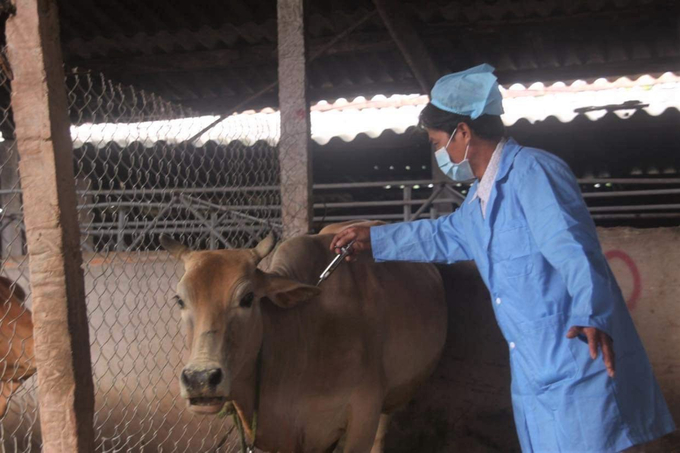
Village level veterinarians are always in close contact with local breeders so they are very good at monitoring diseases. Picture: Vu Dinh Thung.
Closes the gap in the veterinary system
Hoai An is the livestock district in Binh Dinh Province. In terms of pig breeding, Hoai An is known as “the best pigsty in the Central Region”. Although the pig price is low, the pig herd here is still around 260,000 head.
In recent years, Hoai An farmers have greatly developed beef cows, with some households raising as many as 100 hybrid cows, and more recently, Hoai An has also replicated the hill-top chicken raising model. The more livestock in the area, the greater the work pressure on the veterinary staff at all levels, the heavier the responsibility.
According to Mr. Nguyen Thanh Vuong, director of Hoai An District Agricultural Service Center, the epidemic situation in the cattle herds in this district has been brought under control in recent years, which helps farmers in the region to be confident that they will herd again can hold to no less in veterinary power. In Hoai An, there are 14 townships and 1 town with 15 township-level veterinarians, all 82 villages in the district are also covered with village-level animals.
“Both the municipal and village veterinary services are contracted by the municipal people’s committee and paid for from the municipal budget. According to the regulations, community-level veterinarians are entitled to a factor of 1 of the base salary of VND1,490,000/person/month. As for the village veterinarians from before to now, the support money is still 200,000 VND/person/month while they have to both monitor the animal diseases in the area and participate in vaccination. When an epidemic occurs, they have to act immediately It’s so much Work, VND 200,000 per month is not enough to fuel to work, but they still do village with enthusiasm,” shared Mr. Nguyen Thanh Vuong.
According to Mr. Huynh Ngoc Diep, director of the Binh Dinh Animal Husbandry and Veterinary Department, the People’s Council of Binh Dinh Province has approved the “supply” of community and village veterinary medicine in the region from 2006 to now. However, when the Veterinary Medicine Act came into force in 2015, only the municipal level could hire veterinary staff, but not the village level.
However, livestock breeding in Binh Dinh is developing very rapidly, so it is necessary for the village veterinary network to monitor epidemics to prevent the occurrence of diseases in livestock in time, so the communities need to withdraw funds to strengthen the village veterinary network.
“At present, the Animal Husbandry and Veterinary Subdivision of the Department of Agriculture and Rural Development in Binh Dinh has advised to propose to the Provincial People’s Council at the next session in July that the municipalities’ veterinary officers are eligible to work as part-time civil servants in a municipality with a salary coefficient of 1.3 and 100 percent health insurance,” said Mr. Huynh Ngoc Diep, director of Binh Dinh Animal Husbandry and Veterinary Medicine Department.

Community and village level veterinary medicine is very effective in supporting livestock vaccinations. Picture: Vu Dinh Thung.
Strengthening of the district veterinary system
Huynh Ngoc Diep, from 2019 to now, Binh Dinh merged animal husbandry and veterinary stations, phytosanitary station and agricultural advisory station into agricultural service center under the district people’s committee.
However, this merger has the advantage of reducing human resources, but the disadvantage is that the disease epidemic in livestock farming after the merger is no longer the sole responsibility of the veterinary industry, but the responsibility of the animal health industry is the Agricultural Service Center, so that the staff responsible for veterinary medicine are not fully engaged.
Not to mention that the director of the center is a person from the horticultural branch, so the orientation is not closely related to the veterinary branch or vice versa, which means that the implementation of tasks is not distorted anywhere.

Thanks to the good implementation of livestock vaccination, Binh Dinh has managed the disease well over the years. Picture: Vu Dinh Thung.
According to Mr. Diep, Binh Dinh is currently consolidating the district’s veterinary system for the above reason. It’s not a new facility, but how it worked in the past is now restored. Binh Dinh is running a project to drain the former district veterinary system employees to rebuild district veterinary stations.
“Binh Dinh’s agricultural sector is developing a draft to strengthen the district veterinary system, which is expected to be approved by the Binh Dinh Provincial Party Committee by the end of this year. Merging 3 veterinary, agricultural advisory and phytosanitary stations into one agricultural service center can reduce 2 levels of leaders and deputy leaders, but due to the specifics of the agricultural sector, those trained in the field of crop production cannot work effectively in the field of veterinary medicine, therefore without a specialized unit of veterinary medicine at the district level, it will be very difficult to develop livestock farming,” said Mr. Diep.
“In the past, because the county-level veterinary allowance is too small and the money received is not worth it compared to surface work, so many people have resigned. When the veterinary staff was on the payroll of the agricultural service center managed by the district and when the epidemic occurred, the provincial authorities who dispatched the district veterinarian also faced many difficulties,” said Mr. Huynh Ngoc Diep, director of Binh Dinh Animal Husbandry and Veterinary Department.

